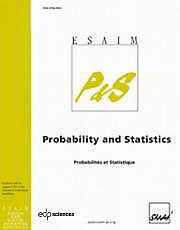Article contents
Nonparametric regression estimation based on spatially inhomogeneous data: minimax global convergence rates and adaptivity
Published online by Cambridge University Press: 06 December 2013
Abstract
We consider the nonparametric regression estimation problem of recovering an unknown response function f on the basis of spatially inhomogeneous data when the design points follow a known density g with a finite number of well-separated zeros. In particular, we consider two different cases: when g has zeros of a polynomial order and when g has zeros of an exponential order. These two cases correspond to moderate and severe data losses, respectively. We obtain asymptotic (as the sample size increases) minimax lower bounds for the L2-risk when f is assumed to belong to a Besov ball, and construct adaptive wavelet thresholding estimators of f that are asymptotically optimal (in the minimax sense) or near-optimal within a logarithmic factor (in the case of a zero of a polynomial order), over a wide range of Besov balls. The spatially inhomogeneous ill-posed problem that we investigate is inherently more difficult than spatially homogeneous ill-posed problems like, e.g., deconvolution. In particular, due to spatial irregularity, assessment of asymptotic minimax global convergence rates is a much harder task than the derivation of asymptotic minimax local convergence rates studied recently in the literature. Furthermore, the resulting estimators exhibit very different behavior and asymptotic minimax global convergence rates in comparison with the solution of spatially homogeneous ill-posed problems. For example, unlike in the deconvolution problem, the asymptotic minimax global convergence rates are greatly influenced not only by the extent of data loss but also by the degree of spatial homogeneity of f. Specifically, even if 1/g is non-integrable, one can recover f as well as in the case of an equispaced design (in terms of asymptotic minimax global convergence rates) when it is homogeneous enough since the estimator is “borrowing strength” in the areas where f is adequately sampled.
Keywords
- Type
- Research Article
- Information
- Copyright
- © EDP Sciences, SMAI 2013
References
- 6
- Cited by


